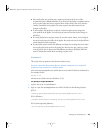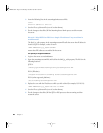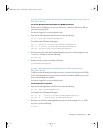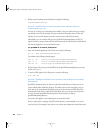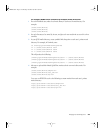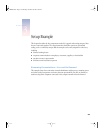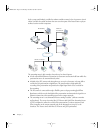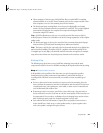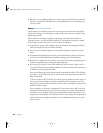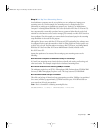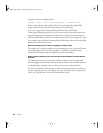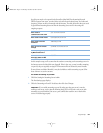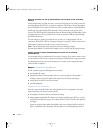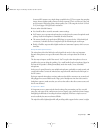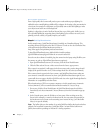Setup Example 57
m Client computers of various types with QuickTime Player or other MPEG-4 compliant
software installed can access the Xserve streaming server via the campus network. Other
client computers can access the streaming server via the Internet.
m The broadcaster laptop running iMovie is used to produce high-quality on-demand
versions of a live presentation after the presentation is concluded. The recorded digitized
presentation is brought into the computer for compression through its FireWire
connection using the DV camera.
Note: QuickTime Broadcaster can be set to record the encoded live stream to disk for
archival purposes. However, it is desirable to encode the footage separately to achieve higher
quality results.
m The broadcaster laptop is also used to control the Xserve remotely through the laptop’s
browser and the QTSS web-based Streaming Server Admin user interface.
Note: The laptop could also be connected to the local network wirelessly via an AirPort base
station for extra portability. The AirPort is 802.11 compliant and works fine with QTSS. Its
11 megabits per second (Mbps) of bandwidth would be more than enough for our example
setup unless other clients were also placing heavy demands on the same base station.
Setting It Up
The following steps show how to set up QuickTime Streaming Server and the other
components needed for live and on-demand streaming in this hypothetical university setting.
Step 1: Prepare the Location
It will probably not be possible to find classrooms on a typical campus that provide a
broadcasting and recording environment comparable to a professional television or
recording studio. Still, there are measures that you can take to ensure reasonably good
results:
m Go into a classroom or lecture room that you want to use for live streaming, close the
doors, and listen for extraneous noise that could interfere with a broadcast. If noise from
a nearby break room, video gaming area, street traffic, or other source is noticeable and
can’t be eliminated, find another room.
m If extraneous noise is not an issue, stand in the center of the room, clap your hands or
shout, and listen for an echo. If you hear an echo, the sound quality of a live broadcast can
be compromised. You can reduce or eliminate echoes by hanging heavy curtains on bare
walls or placing acoustic panels in a checkerboard pattern on each wall.
m Next, examine the floors and furniture. Carpeted floors and padded chairs are best. A
lectern should have a cloth on top, or other padded surface, to protect against noises
such as the speaker’s setting down a glass of water.
LL0329.book Page 57 Wednesday, November 20, 2002 2:09 PM



